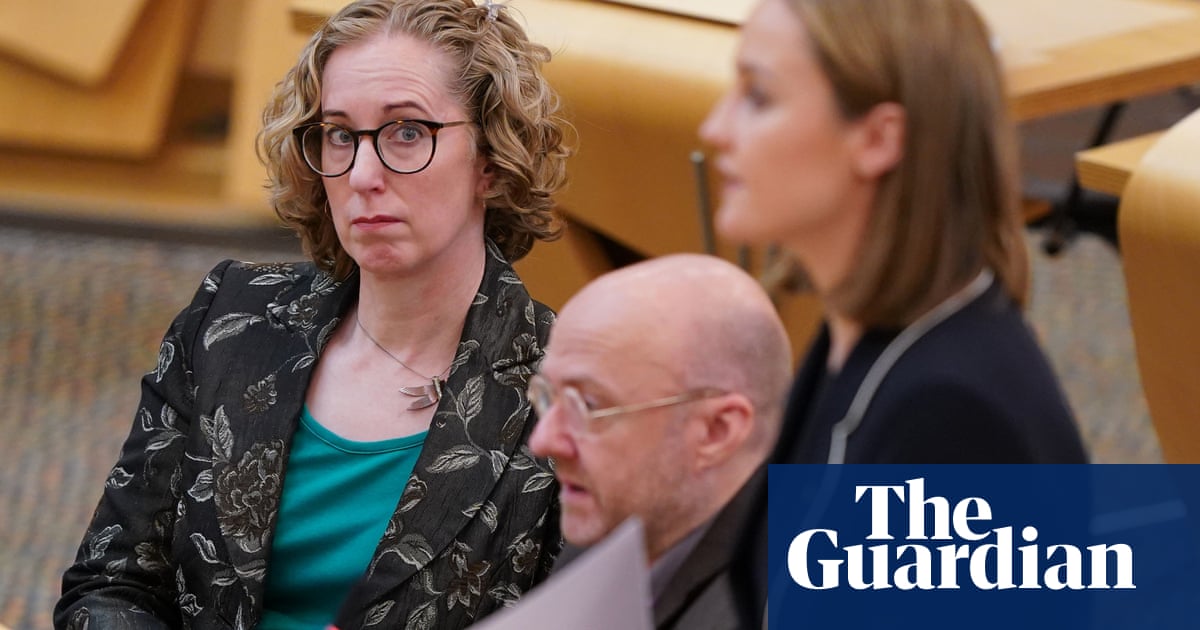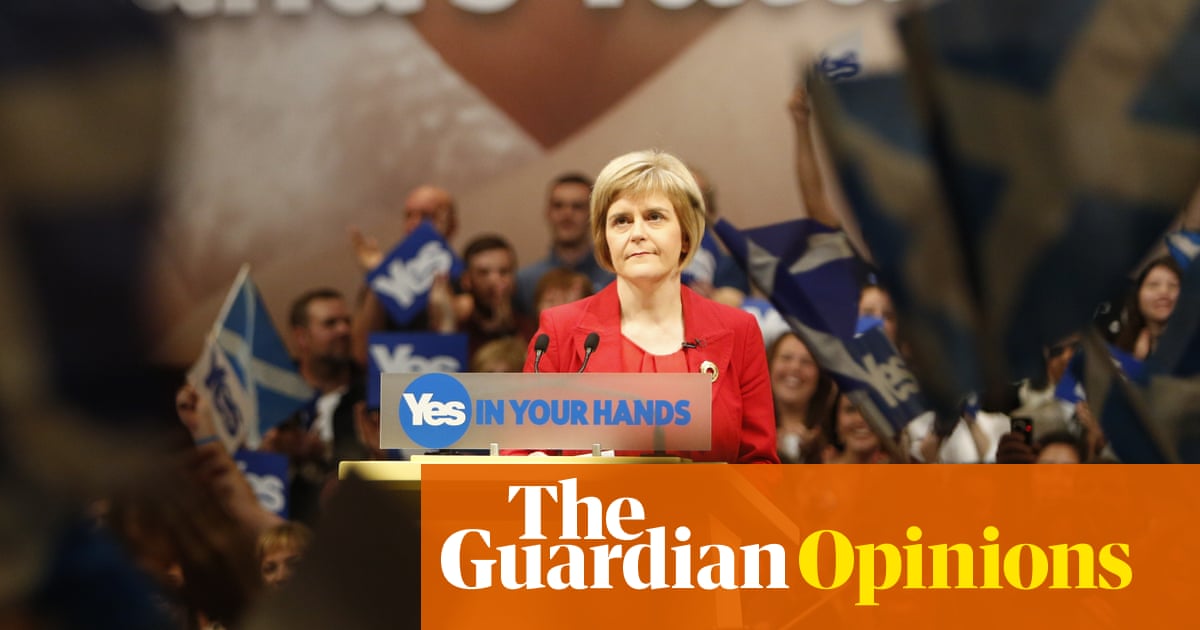
t the press conference to announce the SNP’s landmark cooperation agreement with the Scottish Greens, Nicola Sturgeon could scarcely contain her glee. And no wonder. What better way to burnish her government’s environmental credentials at the UN climate conference, Cop26, in Glasgow than to trumpet its willingness to engage in “grownup politics” for the betterment of the planet?
In Westminster, Boris Johnson is struggling. Earlier this month, a new climate breakdown report reinforced the severity of the crisis. Yet civil servants fear he has left it too late to push the world’s worst polluters to cut their greenhouse gases in order to meet the Paris agreement’s goal of limiting global warming to 1.5C above pre-industrial levels. Having initially refused to give Sturgeon a seat at the Cop26 negotiating table, the prime minister must be spitting feathers at the way she has turned the spotlight on her government at his expense.
Those are the optics, then, months before delegates descend on Glasgow in November. But what’s the reality? Is this hybrid pact – more than a confidence-and-supply agreement, less than a formal coalition – a cynical ploy that will allow the SNP to trade on the Greens’ hard work while forcing them to shoulder the blame for any missteps? Or does it have the potential to produce something transformative; to act as a catalyst for the kind of policies required if the country is to achieve its ambitious climate crisis targets?
A Scottish Green-SNP alliance could transform the country, and the climate
Caroline Lucas
Caroline Lucas
Read more
That’s what the 6,500 members of the Scottish Greens will be asking themselves in the run-up to Saturday’s extraordinary general meeting, when they will have the chance to vote for or against. Are two ministerial posts and two special advisers worth the risk of having their reputation destroyed, as happened to the Lib Dems after they teamed up with David Cameron? Is the potential increase in the party’s influence enough to offset the stifling of its capacity to challenge?
How the SNP benefits from the agreement is obvious. On top of the Cop26 boost, it gives the Scottish government a working majority and helps present a united front in the campaign for a second independence referendum. It freshens up a party exhausted from 14 years in power and helps the SNP stave off criticism that it is too cautious, too centrist, too managerial. The Greens’ more progressive stance (on taxation, on land reform, on gender equality) will appeal to younger SNP members who joined in the wake of 2014, and who are seen as the party’s future.
Advertisement
For the Greens, though, the pluses are fewer and the pitfalls manifold. The party has, at least, offset the risk of a tuition fee-style debacle by securing a list of areas on which they will not be subject to collective responsibility. These include aviation subsidies, the desirability of GDP growth, sex work legislation and an independent Scotland’s membership of Nato.
But you only have to look at the way the SNP took credit for raising the age of free bus passes to under-22s to see how they could be written out of the story. There will also be party members who see any tempering of their environmental ambitions as a sellout.
Judging by their own smiles at last week’s press conference, the Scottish Green party co-leaders, Patrick Harvie and Lorna Slater, are convinced Sturgeon is acting in good faith. Those worried that it will push the SNP too far on green issues have focused on the negatives. They look at the New Zealand deal – on which the Scottish agreement is modelled – and point out it led to prime minister Jacinda Ardern announcing a ban on new offshore oil exploration permits.
In the UK, of course, such decisions are reserved to Westminster, which is convenient given the Scottish government has no desire to spook the oil companies or voters in the north-east who are already drifting towards the Conservatives. The best the draft cooperation agreement has to offer on this front is a £500m fund to aid a just transition away from fossil fuels: a move that falls short of the Greens’ aspirations.
Critics of the deal also point to promised “reviews” and a general vagueness in some key areas. The commitment to a new land reform bill by 2023 has been enough to worry landowners, but could yet be a damp squib.
Still, those who suggest Britain is unused to coalition politics, or who catastrophise about the fate of smaller parties within them, betray their southern perspective. Holyrood was designed for consensus politics. Its first two terms saw effective Labour/Lib Dem coalitions. The outlier was the SNP’s 2011 majority. Given a willingness to work constructively towards common goals, there is no reason this pact could not work well.
There are glints of hope for those who want to find them. Before the agreement was revealed, but under pressure from the Greens, Sturgeon called on the prime minister to review existing drilling licences in the light of the climate emergency, although she stopped short of explicitly opposing the drilling of the Cambo field off Shetland.
And the draft cooperation agreement does contain some ambitious proposals. These include a threefold increase in the proportion of Transport Scotland’s budget spent on active travel initiatives to 10% by 2024-5, and a “fair fares” review to provide a realistic and affordable alternative to car use.
While some of the road-building the SNP committed to in its manifesto, such as the dualling of the A9, looks set to go ahead, the commitment to include climate compatibility assessments in decision-making could impact on the widening of the A96 between Aberdeen and Inverness and make it tougher to advance future projects.
On housing, the parties have agreed to implement an effective national system of rent controls – as demanded by the Living Rent campaign – and an enhancement of tenants’ rights.
A lot will hang on the portfolios the Green ministers secure. Some have suggested they should insist on roles in those areas where the policy gains are likely to be greatest – ie transport and housing – to ensure they keep control of both the agenda and the reputational rewards.
But the success of the collaboration also depends on the relationship struck with the cabinet, the civil service and public bodies such as Transport Scotland, Marine Scotland and NatureScot, which tend towards the conservative.
In New Zealand, the key players have talked about the need to build trust and keep the conversation going. Taken at face value, the draft agreement seems to recognise the importance of this, with structures designed to reassure the Greens they are active partners, not adjuncts there to bolster the Scottish government’s standing. Chief among these is the “no surprises” rule – ensuring both parties are kept abreast of all developments – and a seat on the cabinet sub-committee on legislation.
Harvie and Slater appear to have made a calculation. They believe the SNP knows it must do more on the climate crisis; that it wants to be pushed in the right direction, but that it would prefer to have those arguments behind closed doors – in the hope of reaching a consensus – rather than in the more combative arena of the Holyrood chamber.
Though by far the junior partner, the Scottish Green party will have the ultimate leverage: that of walking away. The question is whether its party leaders are politically adept enough to use that leverage to push the SNP where they want it to go. Or, inside the tent, will their principles be hocked in the grubby pursuit of power?
Dani Garavelli is a freelance journalist
This article was amended on 26 August 2021. An earlier version referred to NatureScot by its previous name, Scottish Natural Heritage.












